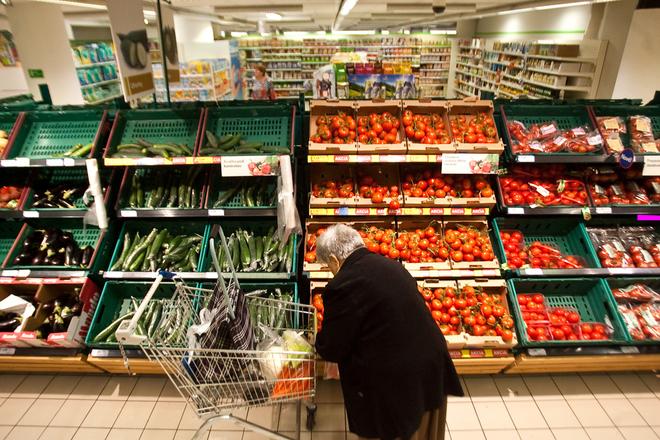Lipšic and the Bandera followers
One picture shows the visit of former MP Daniel Lipšic in Ukraine, the other one shows the march of the Ukrainian radical organisation Tryzub with the portrait of the Ukrainian nationalist Stepan Bandera. The collage was published on February 14 and almost 200 people have seen it.
“Lipšic and Droba supported the revolution in Ukraine. The revolution led by groups supporting the Nazi Bandera. Bandera killed more than a million people,” the caption of the picture reads.

The picture of Lipšic with current Kyiv Mayor Vitali Klitschko now lives its own life on Facebook, but it was taken on February 7, 2014.
This hoax shows how partial information, most of it true, can be used to mix a deceitful cocktail.
Daniel Lipšic, at that time an independent MP, really visited Ukraine together with his parliamentary colleagues Juraj Droba and Jozef Kollar, and supported the Maidan movement.
However, the hoax is based on twisting logic and facts to the effect that if Lipšic supported Maidan, the Maidan people are Bandera followers, and Stepan Bandera could have killed a million people - Lipšic does not mind that?
But Lipšic’s support for Maidan speaks nothing of his opinion about Stepan Bandera, the Ukrainian nationalist who since the 1930s fought for independent Ukraine and in 1959 was killed by the KGB.
The text also equates Maidan (the Ukrainian revolution) with the far right movements (Right Sector, Tryzub). But that is a lie, these far right movements have never been the core of the Ukrainian opposition, they were merely its periphery.
The author of the hoax also put in his collage the Azov volunteer battalion, which, however, only became active in May 2014, after the Russian invasion of Crimea on February 27, 2014. That is three months after Lipšic visited Kyiv.
Calling Stepan Bandera a Nazi conforms with the Russian attempts to deform the regional history. Bandera was a nationalist who fought for independent Ukraine and considered its membership in the Soviet Union a Russian occupation.
In his efforts to resist Moscow he joined forces with the Third Reich for a while, but before long the Germans ceased to trust him and prepared his physical liquidation. In the summer of 1941 Bandera was arrested by the Gestapo and held in Berlin. Later, he was also imprisoned in the Sachsenhausen concentration camp.
Searching on the internet and in media archives fails to return any of Lipšic’s statements in support of Bandera or Ukrainian radicals.
The vegetable disaster
European customers face a shortage of vegetables in their shops. Stores in the UK, Norway, and Denmark, are usually empty. And the pieces that are still available are on rations.
A few days ago, one of the Russian state television outlets reported that Europe was facing a major food crisis. The report showed pictures of empty shelves in supermarkets. They resembled scenes from the shops in the times of real socialism.
But there was no “vegetable disaster”. The report of the Russian First Channel is based on the reports of the British tabloid Daily Mail, while serious British media talk about a few cases when customers could not buy some iceberg salad in their local supermarkets, but that did not mean any major food crisis.
Checking into the Russian claims in Norway reveals that the unstable weather, rain, and frost have had a moderate influence on the increase of prices of lettuce and some other types of vegetables. The biggest state supplier of fruits and vegetables, however, denied the claims about problems reported by the Russian television.
In Denmark, there was also no trace of any major crisis, even though the prices of some sorts of vegetables increased by about 10 percent.
The Russian hoax about a food crisis shows the classic signs of a hoax and fake news, according to the EuropeanDisinformation review: it blows up a small problem, hides some key details and adds some others, making the result sound partially or completely different to facts. The aim of this is allegedly to support the Russian media line that should describe the fall of Europe.
Zombies in Ukraine
Members of the Ukrainian armed forces fight under the influence of strong drugs in Donbass, thanks to which they feel no pain and live even after being shot several times.
The Czech website Sputnik last week published similar information, citing the Russian daily Izvestia.
It cites a statement of the deputy commander of the armed forces of the Donbass separatist unit Eduard Basurin.
“Stories of cyborgs are no fairy tales,” Basurin allegedly said. “First we came in touch with pills, then we found containers with the inscription Water of Life at the airport. We sent them to the lab and it turned out that it is an immensely strong psychotropic substance after which a person feels no more pain or fear.”
He said the Ukrainian soldiers look like zombies.
“You could shoot an entire cartridge into them and they would go on… You kill him and he goes on. You shoot at him and he falls down, and then stands up again and goes on. Unless you shoot him in the head or in the heart.”
It is questionable how serious it would be to deal with such claims. Scientists have so far not found any evidence of the existence of zombies, and the biggest scientific database Cochrane only returns two studies when searching for the keyword zombie - they both researched the impact of computer games on the mind.
Scientists have, however, tested so-called animal cyborgs, for example, bugs that had electrodes implanted in their muscles and to some extent they can control their movements. But the research is still in its early stages and there has been no similar research on people. Obviously, various substances may influence the way a person experiences events and the world around him. However, it is not possible that such substances would cause “invincibility” or keep a person ready for combat even after being critically wounded.
Migrants in Slovakia
Kaliňák paid €2.8 million to accept migrants, while Slovak children suffer without treatment.
This claim of the extremist LSNS from February 1 creates the impression that the state sent 2.8 million from its budget to NGOs securing the needs of immigrants in Slovakia.
The illustration photo-collage depicts Interior Minister Robert Kaliňák with the text: “2.8 million euros for accepting migrants”. This money could have been used for example for the treatment of children, the author writes.
The claim adopted from a conspiracy website is based on four grant agreements for the Slovak Humanity Council, Marginal Civic Association, and the Human Rights League. In reality, the Interior Ministry sent €705,000 to these institutions and the rest goes from the Fund for Asylum, Migration, and Integration. The money from the fund is to allow for a dignified waiting period of the migrants until their asylum request is processed, and for their subsequent integration if the country accepts them. This money goes not for the automatic “accepting of migrants”. It also cannot be used for the treatment of children, for instance.
It is also not true that Slovak children receive insufficient treatment. The Slovak Constitution guarantees free-of-charge health care also for children.
The state pays for the health care of children, since they are insurees of the state. On the other hand, it happens that the insurance companies do not pay for some above-standard services and parents have to procure the money to pay for them.
While the authors of the hoax use several facts, at the same time they suggest half-truths or complete fabrications. Together with a photomontage and the title they thus create the impression that the state sends millions for accepting migrants, which is a lie.
The Slovak Spectator brings the selection of hoaxes that were published on the internet and shared by Slovak users on social networks in cooperation with the Sme daily, whichruns the project aimed at spotting hoaxes and confronting them with facts.



 (source: SME)
(source: SME)